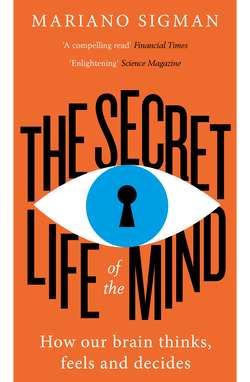Читать книгу The Secret Life of the Mind: How Our Brain Thinks, Feels and Decides - Mariano Sigman - Страница 17
Mother tongue
ОглавлениеOur brains are prepared and predisposed for language from the day we are born. But this predisposition does not seem to materialize without social experience, without using it with other people. This conclusion comes from studies of feral children who grow up without any human contact. One of the most emblematic is Kaspar Hauser, magnificently portrayed in the eponymous film directed by Werner Herzog. Kaspar Hauser’s story of confinement for the duration of his childhoodfn8 shows that it is very difficult to acquire language when it has not been practised early in life. The ability to speak a language, to a large extent, is learned in a community. If a child grows up in complete isolation from others, his or her ability to learn a language is largely impaired. Herzog’s film is, in many ways, a portrait of that tragedy.
The brain’s predisposition for a universal language becomes fine-tuned by contact with others, acquiring new knowledge (grammatical rules, words, phonemes) or unlearning differences that are irrelevant to one’s mother tongue.
The specialization of language happens first with phonemes. For example, in Spanish there are five vowel sounds, while in French, depending on the dialect, there are up to seventeen (including four nasal vowel sounds). Non-French speakers often do not perceive the difference between some of these vowel sounds. For instance, native Spanish speakers typically do not distinguish the difference between the sounds of the French words cou (pronounced [ku]) and cul (pronounced [ky]) which may lead to some anatomical misunderstanding since cou means neck and cul means bum. Vowels that they perceive as [u] in both cases sound completely different for a French speaker, as much so as an ‘e’ and an ‘a’ for Spanish speakers. But the most interesting part is that all the children of the world, French or not, can recognize those differences during the first few months of life. At that point in our development we are able to detect differences that as adults would be impossible for us.
In effect, a baby has a universal brain that is able to distinguish phonological contrasts in every language. Over time, each brain develops its own phonological categories and barriers that depend on the specific use of its language. In order to understand that an ‘a’ pronounced by different people, in varying contexts, at different distances, with head colds and without, corresponds to the same ‘a’, one has to establish a category of sounds. Doing this means, unfailingly, losing resolution. Those borders for identifying phonemes in the space of sounds are established between six and nine months of life. And they depend, of course, on the language we hear during development. That is the age when our brain stops being universal.
After the early stage in which phonemes are established, it is time for words. Here there is a paradox that, on the face of it, seems hard to resolve. How can babies know which are the words in a language? The problem is not only how to learn the meaning of the thousands of words that make it up. When someone hears a phrase in German for the first time, not only do they not know what each word means but they can’t even distinguish them in the sound continuum of the phrase. That is due to the fact that in spoken language there are no pauses that are equal to the space between written words. Thatmeansthatlisteningtosomeonespeakisliketryingtoreadthis.fn9 And if babies don’t know which are the words of a language, how can they recognize them in that big tangle?
One solution is talking to babies – as we do when speaking Motherese – slowly and with exaggerated enunciation. In Motherese there are pauses between words, which facilitates the baby’s heroic task of dividing a sentence into the words that make it up.
But this doesn’t explain per se how eight-month-olds already begin to form a vast repertoire of words, many of which they don’t even know how to define. In order to do this, the brain uses a principle similar to the one many sophisticated computers employ to detect patterns, known as statistical learning. The recipe is simple and identifies the frequency of transitions between syllables and function. Since the word hello is used frequently, every time the syllable ‘hel’ is heard, there is a high probability that it will be followed by the syllable ‘lo.’ Of course, these are just probabilities, since sometimes the word will be helmet or hellraiser, but a child discovers, through an intense calculation of these transitions, that the syllable ‘hel’ has a relatively small number of frequent successors. And so, by forming bridges between the most frequent transitions, the child can amalgamate syllables and discover words. This way of learning, obviously not a conscious one, is similar to what smartphones use to complete words with the extension they find most probable and feasible; as we know, they don’t always get it right.
This is how children learn words. It is not a lexical process as if filling a dictionary in which each word is associated with its meaning or an image. To a greater extent, the first approach to words is rhythmic, musical, prosodic. Only later are they tinged with meaning. Marina Nespor, an extraordinary linguist, suggests that one of the difficulties of studying a second language in adulthood is that we no longer use that process. When adults learn a language, they usually do so deliberately and by using their conscious apparatus; they try to acquire words as if memorizing them from a dictionary and not through the musicality of language. Marina maintains that if we were to imitate the natural mechanism of first consolidating the words’ music and the regularities in the language’s intonation, our process of learning would be much simpler and more effective.
